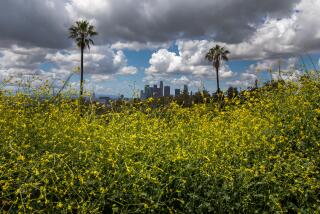Tomatoes That Let You Get a Jump on Early Plantings
- Share via
April is the traditional month to plant tomatoes in Southland gardens--certainly not February.
However, if you have a gambling spirit, you may be able to enjoy an extremely early harvest of tomatoes if you set out the plants this month. Not any plants, mind you. Most tomato varieties simply will bide their time--or worse--when planted this early.
There is, however, a tomato variety designed to produce early fruit in cool weather. It’s called Early Girl, and plants are available in local nurseries.
Earlier Tomatoes
Each February, I plant several plants of Early Girl and with good luck, I have fruit by late April--two months ahead of the normal harvest.
The reason that Early Girl produces fruit so early is that it has the ability to set fruit at lower temperatures than most other tomato varieties. Most tomato plants won’t set fruit if the nighttime temperature falls below 55 degrees Fahrenheit. Early Girl will set fruit under considerably lower temperature conditions.
Early Girl produces a medium-size, good-tasting tomato at a period of time when the only other tomatoes available are those bland, tasteless rocks from the supermarket. The fruit is produced on large, sprawling vines that require caging or staking.
Of course, by planting in February you run the risk of losing the plants to an unseasonable frost. However, in many coastal areas of Southern California, a hard frost this late is unlikely. I’ve never lost a tomato plant to frost in February. Foothill and Inland Valley gardeners, some of whom experienced snow last week, should probably wait until March to try this early tomato variety.
Early Girl has the same growing requirements as other tomato plants. Choose an area of the garden that receives at least seven hours of sun daily--the more the better. Work generous quantities of organic material into the soil. If the soil tends to be alkaline, as much of the soil in the Southland is, peat moss is a valuable organic addition. When working the soil, add a vegetable fertilizer, following label instructions as to amount. Water the soil thoroughly and allow it to settle for two days before planting.
Recovery Time
Transplant the young plants into the garden in late afternoon when they will have the cool of the evening to recover.
Remove the plants from the container, leaving an equal amount of soil and root system on each plant. Planting holes should be 2 to 3 feet apart and should be deep, with the plants set at a deeper level than they were in the container. Remove the lower leaves along the stem and bury the plant to within 2 to 3 inches of its topmost foliage.
During the transplanting process, water the plants gently with a sprinkling can. For the first five days after transplanting, give the plants a light watering once a day.
When young plants are established, water deeply on a weekly basis (tomatoes grown in containers need far more frequent watering). After the plants begin to set fruit, it will pay to sprinkle some vegetable fertilizer around them on a monthly basis. Always water thoroughly after fertilizing.
Spreading black plastic mulch between plants eliminates weeding and speeds up growth. Always put drainage slits in the plastic so water can get through. Control those tomato worms by using Dipel, Attack or Thuricide, which are biological controls that are not harmful to beneficial insects. Spray every 10 days and follow the label instructions.
In addition to early tomatoes, February presents an interesting month in the vegetable garden. It is the last practical month to plant the bare-root vegetables: artichokes, asparagus, rhubarb and horseradish. It is the best month of the year to plant all lettuce types, except head lettuce.
There is a wide selection of strawberry plants in local nurseries this month. February is the best month to plant potatoes from seed potatoes in our area. Many gardeners are enjoying growing some of the more unusual potatoes such as Yellow Finn, Peruvian Blue and Yellow Fingerling, all of which have recently become available as seed potatoes.
Others to Plant
Other vegetables to plant this month include beets, broccoli, cabbage, carrots, celery, endive, kale, kohlrabi, leeks, onions, parsnips, peas, radishes, salsify, spinach, Swiss chard and turnips.
Ironically, some nurseries will have pepper plants for sale this month. Avoid them. April is the earliest to successfully set out pepper plants. If planted now, they will simply sulk and experience almost no growth until the weather warms up. The growth of the plants will be greatly retarded and they will never reach their potential.






